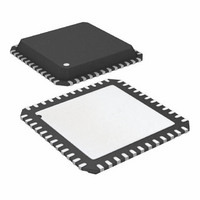AD7667ACP Analog Devices Inc, AD7667ACP Datasheet - Page 19

AD7667ACP
Manufacturer Part Number
AD7667ACP
Description
IC ADC 16BIT UNIPOLAR 48-LFCSP
Manufacturer
Analog Devices Inc
Series
PulSAR®r
Datasheet
1.AD7667ASTZ.pdf
(28 pages)
Specifications of AD7667ACP
Rohs Status
RoHS non-compliant
Number Of Bits
16
Sampling Rate (per Second)
1M
Data Interface
Serial, Parallel
Number Of Converters
1
Power Dissipation (max)
145mW
Voltage Supply Source
Analog and Digital
Operating Temperature
-40°C ~ 85°C
Mounting Type
Surface Mount
Package / Case
48-VFQFN, CSP Exposed Pad
For Use With
EVAL-AD7667CBZ - BOARD EVALUATION FOR AD7667
•
•
The
almost all applications. The
compensation capacitor that should have good linearity as an
NPO ceramic or mica type. Moreover, the use of a noninverting
+1 gain arrangement is recommended and helps to obtain the
best signal-to-noise ratio.
The
gain of 1 is present. The
where high frequency (above 100 kHz) performance is not
required. In gain of 1 applications, it requires an 82 pF
compensation capacitor. The
bias current is needed in low frequency applications.
AD8021
AD8022
The noise generated by the driver amplifier needs to be
kept as low as possible in order to preserve the SNR and
transition noise performance of the AD7667. The noise
coming from the driver is filtered by the AD7667 analog
input circuit 1-pole low-pass filter made by R1 and C2 or
by the external filter, if one is used. The SNR degradation
due to the amplifier is
where:
f
N
e
For instance, a driver with an equivalent input noise of
2 nV/√Hz, like the AD8021 with a noise gain of +1 when
configured as a buffer, degrades the SNR by only 0.13 dB
when using the filter in Figure 26 and by 0.43 dB without.
The driver needs to have a THD performance suitable to
that of the AD7667. Figure 15 gives the THD versus
frequency that the driver should exceed.
–3dB
N
is the noise factor of the amplifier (+1 in buffer
configuration).
is the input bandwidth of the AD7667 (13 MHz) or
the cutoff frequency of the input filter (3.9 MHz), if
one is used.
is the equivalent input noise voltage of the op amp, in
nV/√Hz.
SNR
meets these requirements and is appropriate for
could also be used if a dual version is needed and
LOSS
=
20
log
AD829
AD8021
⎛
⎜
⎜
⎜
⎜
⎝
AD8610
784
is an alternative in applications
+
needs a 10 pF external
π
2
is an option when low
28
f
−
3
dB
(
Ne
N
)
2
⎞
⎟
⎟
⎟
⎟
⎠
Rev. 0 | Page 19 of 28
Voltage Reference Input
The AD7667 allows the choice of either a very low temperature
drift internal voltage reference or an external 2.5 V reference.
Unlike many ADCs with internal references, the internal
reference of the AD7667 provides excellent performance and
can be used in almost all applications.
To use the internal reference along with the internal buffer,
PDREF and PDBUF should both be LOW. This produces 1.2 V
on REFBUFIN which, amplified by the buffer, results in a 2.5 V
reference on the REF pin.
The output impedance of REFBUFIN is 11 kΩ (minimum)
when the internal reference is enabled. It is necessary to
decouple REFBUFIN with a ceramic capacitor greater than
10 nF. Thus the capacitor provides an RC filter for noise
reduction.
To use an external reference along with the internal buffer,
PDREF should be HIGH and PDBUF should be LOW. This
powers down the internal reference and allows the 2.5 V
reference to be applied to REFBUFIN.
To use an external reference directly on REF pin, PDREF and
PDBUF should both be HIGH.
PDREF and PDBUF power down the internal reference and the
internal reference buffer, respectively. Note that the PDREF and
PDBUF input current should never exceed 20 mA. This could
eventually occur when input voltage is above AVDD (for
instance, at power-up). In this case, a 100 Ω series resistor is
recommended.
The internal reference is temperature compensated to 2.5 V
±7 mV. The reference is trimmed to provide a typical drift of
3 ppm/°C . This typical drift characteristic is shown in
Figure 22. For improved drift performance, an external
reference, such as the AD780, can be used.
The AD7667 voltage reference input REF has a dynamic input
impedance; it should therefore be driven by a low impedance
source with efficient decoupling between the REF and
REFGND inputs. This decoupling depends on the choice of the
voltage reference but usually consists of a low ESR tantalum
capacitor connected to REF and REFGND with minimum
parasitic inductance. A 10 µF (X5R, 1206 size) ceramic chip
capacitor (or 47 µF tantalum capacitor) is appropriate when
using either the internal reference or one of these
recommended reference voltages:
•
•
•
The low noise, low temperature drift
The low power
The low cost
AD1582
ADR291
ADR421
and
AD7667
AD780












